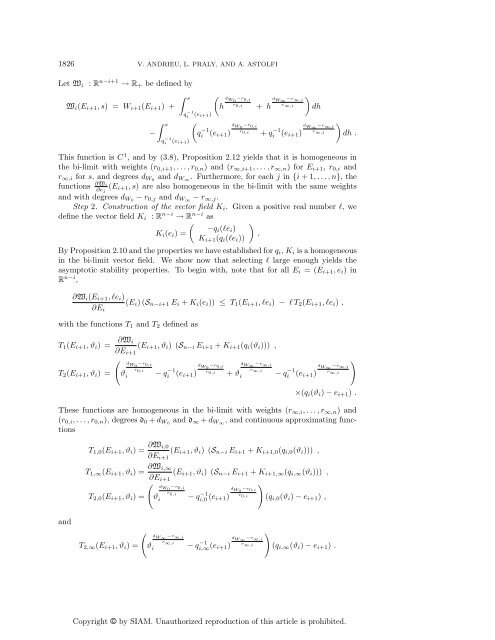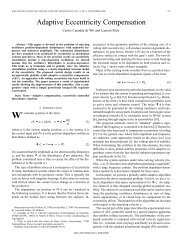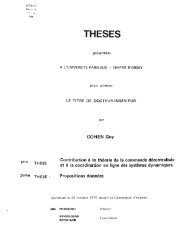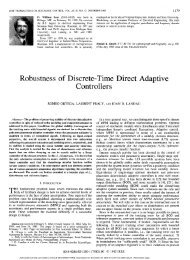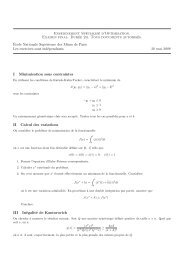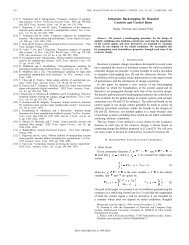Copyright © by SIAM. Unauthorized reproduction of this article is ...
Copyright © by SIAM. Unauthorized reproduction of this article is ...
Copyright © by SIAM. Unauthorized reproduction of this article is ...
Create successful ePaper yourself
Turn your PDF publications into a flip-book with our unique Google optimized e-Paper software.
1826 V. ANDRIEU, L. PRALY, AND A. ASTOLFILet W i: R n−i+1 → R + be defined <strong>by</strong>W i (E i+1 ,s) = W i+1 (E i+1 )+∫ s−∫ sq −1i (e i+1)q −1i (e i+1)(d W0 −r 0,irh 0,i)d W∞ −r ∞,i+ hr ∞,idh(dq −1W0 −r 0,iri (e i+1 ) 0,i+ q −1d W∞ −r ∞,i)ri (e i+1 ) ∞,idh .Th<strong>is</strong> function <strong>is</strong> C 1 , and <strong>by</strong> (3.8), Proposition 2.12 yields that it <strong>is</strong> homogeneous inthe bi-limit with weights (r 0,i+1 ,...,r 0,n ) and (r ∞,i+1 ,...,r ∞,n ) for E i+1 , r 0,i andr ∞,i for s, and degrees d W0 and d W∞ . Furthermore, for each j in {i +1,...,n}, thefunctions ∂Wi∂e j(E i+1 ,s) are also homogeneous in the bi-limit with the same weightsand with degrees d W0 − r 0,j and d W∞ − r ∞,j .Step 2. Construction <strong>of</strong> the vector field K i . Given a positive real number l, wedefine the vector field K i : R n−i → R n−i as()−qK i (e i )=i (le i ).K i+1 (q i (le i ))By Proposition 2.10 and the properties we have establ<strong>is</strong>hed for q i , K i <strong>is</strong> a homogeneousin the bi-limit vector field. We show now that selecting l large enough yields theasymptotic stability properties. To begin with, note that for all E i =(E i+1 ,e i ) inR n−i ,∂W i (E i+1 , le i )∂E i(E i )(S n−i+1 E i + K i (e i )) ≤ T 1 (E i+1 , le i ) − lT 2 (E i+1 , le i ) ,with the functions T 1 and T 2 defined asT 1 (E i+1 ,ϑ i )=T 2 (E i+1 ,ϑ i )=∂W i(E i+1 ,ϑ i )(S n−i E i+1 + K i+1 (q i (ϑ i ))) ,∂E i+1(dϑ − q −1W0 −r 0,iri (e i+1 ) 0,id W0 −r 0,ir 0,ii)d W∞ −r ∞,ir+ ϑ∞,ii − q −1d W∞ −r ∞,iri (e i+1 ) ∞,i×(q i (ϑ i ) − e i+1 ) .These functions are homogeneous in the bi-limit with weights (r ∞,i ,...,r ∞,n ) and(r 0,i ,...,r 0,n ), degrees d 0 + d W0 and d ∞ + d W∞ , and continuous approximating functionsT 1,0 (E i+1 ,ϑ i )= ∂W i,0∂E i+1(E i+1 ,ϑ i )(S n−i E i+1 + K i+1,0 (q i,0 (ϑ i ))) ,T 1,∞ (E i+1 ,ϑ i )= ∂W i,∞(E i+1 ,ϑ i )(S n−i E i+1 + K i+1,∞ (q i,∞ (ϑ i ))) ,∂E i+1()dT 2,0 (E i+1 ,ϑ i )= ϑ − q −1i,0 (e W0 −r 0,iri+1) 0,i(q i,0 (ϑ i ) − e i+1 ) ,d W0 −r 0,ir 0,iiandT 2,∞ (E i+1 ,ϑ i )=(ϑd W∞ −r ∞,ir ∞,ii)d W∞ −r ∞,i− q −1i,∞ (e i+1)r ∞,i(q i,∞ (ϑ i ) − e i+1 ) .<strong>Copyright</strong> © <strong>by</strong> <strong>SIAM</strong>. <strong>Unauthorized</strong> <strong>reproduction</strong> <strong>of</strong> <strong>th<strong>is</strong></strong> <strong>article</strong> <strong>is</strong> prohibited.


